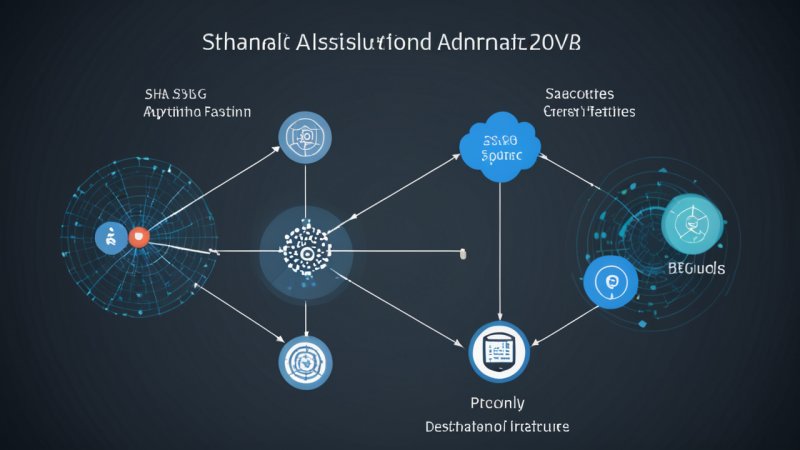Cryptographic hashing algorithms play a pivotal role in ensuring data integrity, security, and the functioning of blockchain technology. Among the myriad of hashing algorithms available, SHA-256 and SHA-3 stand out due to their widespread adoption and robust security features. This article delves into a detailed comparison of these two hashing algorithms, examining their advantages, disadvantages, and practical applications.
Understanding Cryptographic Hashing
Before diving into the specifics of SHA-256 and SHA-3, it is essential to understand what cryptographic hashing entails. A cryptographic hash function takes an input (or 'message') and produces a fixed-size string of bytes that appears random. The output, known as a hash value or digest, is unique to each unique input. This characteristic makes hashing functions indispensable in various applications, including data integrity verification, digital signatures, and password storage.
Overview of SHA-256
SHA-256, short for Secure Hash Algorithm 256-bit, is a member of the SHA-2 family, designed by the National Security Agency (NSA) in 2001. It has gained prominence primarily due to its use in Bitcoin and other cryptocurrencies.
- Bit Length: Produces a 256-bit hash value.
- Security Level: Currently considered secure against pre-image attacks and collision attacks.
- Performance: Generally fast but can be slower than some newer algorithms.
Pros of SHA-256
- Strong security and resistance to attacks.
- Widely adopted in blockchain and cryptocurrencies, ensuring a vast ecosystem.
- Simple implementation and extensive documentation.
Cons of SHA-256
- Slower performance compared to some newer hashing algorithms.
- Vulnerability to length extension attacks (if not properly implemented).
Overview of SHA-3
SHA-3, released in 2015 and developed by the Keccak team, is distinct from SHA-2 in that it employs a different construction method known as sponge construction. It is designed to provide additional security and flexibility.
- Bit Length: Offers variable bit lengths, including 224, 256, 384, and 512 bits.
- Security Level: Designed to be secure against various attack vectors, including collision and pre-image attacks.
- Performance: Generally more efficient in various applications than SHA-256.
Pros of SHA-3
- Offers flexibility with variable output lengths.
- More efficient for certain applications and resistant to length extension attacks.
- Designed with modern cryptographic principles, making it a forward-looking choice.
Cons of SHA-3
- Less widespread adoption compared to SHA-256.
- Implementation may be more complex due to its unique construction.
Comparative Analysis
When comparing SHA-256 and SHA-3, several factors come into play, influencing the choice of hashing algorithm based on specific use cases.
Security
Both SHA-256 and SHA-3 are currently considered secure, but SHA-3 is designed to be more resilient against future attack methodologies. While SHA-256 has been the go-to choice for cryptocurrencies, SHA-3's innovative design offers a promising alternative, especially for new applications.
Performance
SHA-3 generally performs better in terms of speed and efficiency, especially in hardware implementations. SHA-256, while secure, tends to be slower and less efficient in certain scenarios, particularly with larger datasets.
Adoption and Ecosystem
SHA-256 is deeply entrenched in the cryptocurrency ecosystem, particularly with Bitcoin. Its widespread adoption means that many applications and systems are designed around its use. In contrast, SHA-3 is newer and has a smaller ecosystem, although it is gaining traction.
Implementation Complexity
SHA-256 is simpler to implement due to extensive libraries and examples available. SHA-3, while offering unique advantages, may require more effort to integrate effectively due to its sponge construction.
Practical Applications
SHA-256 Applications
SHA-256 is predominantly used in blockchain technology, particularly in Bitcoin for creating blocks and verifying transactions. It is also utilized in various security protocols, including SSL/TLS and digital signatures.
SHA-3 Applications
SHA-3, while still emerging, is being integrated into new applications that require enhanced security features. It is suitable for digital signatures, password hashing, and applications where variable hash lengths are beneficial.
Conclusion
In conclusion, both SHA-256 and SHA-3 have their strengths and weaknesses. SHA-256, with its established history and widespread use, continues to be a strong contender in the realm of cryptographic hashing. On the other hand, SHA-3 offers innovative features and improved performance, making it a compelling choice for future applications. Ultimately, the choice between the two should be guided by specific use case requirements, the need for security, and performance considerations.






